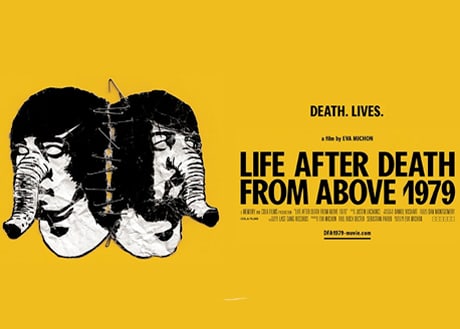If Death From Above 1979 learned anything between the release of their debut and last month's long overdue followup, it's how to milk an album launch for all its worth.
Life After Death From Above 1979 caps off a month of promotional events, including a pop-up shop and a pair of secret shows in the band's hometown, Toronto. A doc chronicling the rise, fall and rebirth of a band isn't a new move — lots of artists use films about their past to drum up interest in their present — but Life After Death From Above 1979 goes one step further, answering the question Jesse F. Keeler and Sebastien Grainger have steadfastly avoided answering since reforming in 2011 — why they broke up in the first place.
Running a tight 70-minutes, the flick is primarily built around the initial reaction to the duo's reunion and their main stage set at Coachella. Conveniently sidestepping how the two met (they've never given a straight answer) the film starts with Keeler's old band Femme Fatale, for whom Grainger would occasionally drum. DFA1979, they say, was born out of boredom in Toronto's east end in the early 2000s. It then works through the release of their debut EP, signing with Last Gang for their debut full-length (which went on to sell over 100,000 copies) and the gruelling string of tours that eventually broke their friendship and led Keeler to the bottle.
Keeler and Grainger didn't speak for five years, a rift exacerbated by Keeler's success with MSTRKRFT. The Coachella offer initiated the reunion, but the film captures the unique bond between the two musicians, especially during their initial rehearsals together.
This personal dynamic lies at the heart of the film. Director Eva Michon rightly recognized that while they might not always get along, Keeler and Grainger have a mutual respect for one another. And as much as they might benefit financially from playing together, the band's long-term success — including recording their new album, The Physical World — hinged on real reconciliation, not just a Band-Aid. A particularly moving scene finds Keeler detailing his heartfelt apology to Grainger.
Those unconvinced of DFA 1979's greatness and legacy will find little to like here. Although Michon doesn't build the group up to be anything that they're not, there's no effort to unveil new sides to their sonic assault. Life After Death From Above 1979 is a fairly by-the-book doc, featuring plenty of talking heads and archival footage that will carry plenty of meaning for fans.
Yet by deciding not to build her subjects up, Michon is able to reveal them as their real selves — creative yet complicated people with many of the same problems their fans have. It's this subtext that will ultimately win viewers over and ensure that Life After Death From Above 1979 lives on long after the current press cycle is over.
(Memory)Life After Death From Above 1979 caps off a month of promotional events, including a pop-up shop and a pair of secret shows in the band's hometown, Toronto. A doc chronicling the rise, fall and rebirth of a band isn't a new move — lots of artists use films about their past to drum up interest in their present — but Life After Death From Above 1979 goes one step further, answering the question Jesse F. Keeler and Sebastien Grainger have steadfastly avoided answering since reforming in 2011 — why they broke up in the first place.
Running a tight 70-minutes, the flick is primarily built around the initial reaction to the duo's reunion and their main stage set at Coachella. Conveniently sidestepping how the two met (they've never given a straight answer) the film starts with Keeler's old band Femme Fatale, for whom Grainger would occasionally drum. DFA1979, they say, was born out of boredom in Toronto's east end in the early 2000s. It then works through the release of their debut EP, signing with Last Gang for their debut full-length (which went on to sell over 100,000 copies) and the gruelling string of tours that eventually broke their friendship and led Keeler to the bottle.
Keeler and Grainger didn't speak for five years, a rift exacerbated by Keeler's success with MSTRKRFT. The Coachella offer initiated the reunion, but the film captures the unique bond between the two musicians, especially during their initial rehearsals together.
This personal dynamic lies at the heart of the film. Director Eva Michon rightly recognized that while they might not always get along, Keeler and Grainger have a mutual respect for one another. And as much as they might benefit financially from playing together, the band's long-term success — including recording their new album, The Physical World — hinged on real reconciliation, not just a Band-Aid. A particularly moving scene finds Keeler detailing his heartfelt apology to Grainger.
Those unconvinced of DFA 1979's greatness and legacy will find little to like here. Although Michon doesn't build the group up to be anything that they're not, there's no effort to unveil new sides to their sonic assault. Life After Death From Above 1979 is a fairly by-the-book doc, featuring plenty of talking heads and archival footage that will carry plenty of meaning for fans.
Yet by deciding not to build her subjects up, Michon is able to reveal them as their real selves — creative yet complicated people with many of the same problems their fans have. It's this subtext that will ultimately win viewers over and ensure that Life After Death From Above 1979 lives on long after the current press cycle is over.
